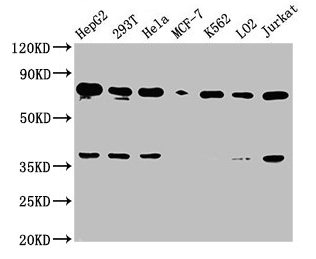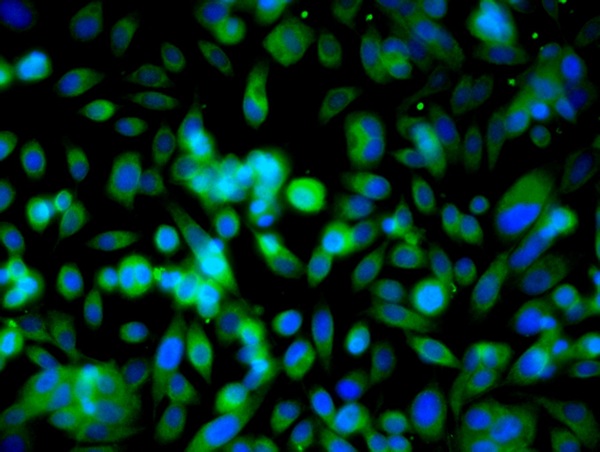
Western Blot Positive WB detected in: HepG2 whole cell lysate, 293T whole cell lysate, Hela whole cell lysate, MCF-7 whole cell lysate, K562 whole cell lysate, LO2 whole cell lysate, Jurkat whole cell lysate All lanes: UBC antibody at 1:2000 Secondary Goat polyclonal to rabbit IgG at 1/50000 dilution Predicted band size: 78 kDa Observed band size: 78 kDa
UBC Antibody
CSB-PA03742A0RB
ApplicationsWestern Blot, ELISA
Product group Antibodies
ReactivityHuman
TargetUBC
Overview
- SupplierCusabio
- Product NameUBC Antibody
- Delivery Days Customer20
- ApplicationsWestern Blot, ELISA
- CertificationResearch Use Only
- ClonalityPolyclonal
- ConjugateUnconjugated
- Gene ID7316
- Target nameUBC
- Target descriptionubiquitin C
- Target synonymsHMG20, polyubiquitin-C
- HostRabbit
- IsotypeIgG
- Protein IDP0CG48
- Protein NamePolyubiquitin-C
- Scientific DescriptionUbiquitin: Exists either covalently attached to another protein, or free (unanchored). When covalently bound, it is conjugated to target proteins via an isopeptide bond either as a monomer (monoubiquitin), a polymer linked via different Lys residues of the ubiquitin (polyubiquitin chains) or a linear polymer linked via the initiator Met of the ubiquitin (linear polyubiquitin chains). Polyubiquitin chains, when attached to a target protein, have different functions depending on the Lys residue of the ubiquitin that is linked: Lys-6-linked may be involved in DNA repair; Lys-11-linked is involved in ERAD (endoplasmic reticulum-associated degradation) and in cell-cycle regulation; Lys-29-linked is involved in lysosomal degradation; Lys-33-linked is involved in kinase modification; Lys-48-linked is involved in protein degradation via the proteasome; Lys-63-linked is involved in endocytosis, DNA-damage responses as well as in signaling processes leading to activation of the transcription factor NF-kappa-B. Linear polymer chains formed via attachment by the initiator Met lead to cell signaling. Ubiquitin is usually conjugated to Lys residues of target proteins, however, in rare cases, conjugation to Cys or Ser residues has been observed. When polyubiquitin is free (unanchored-polyubiquitin), it also has distinct roles, such as in activation of protein kinases, and in signaling.
- ReactivityHuman
- Storage Instruction-20°C or -80°C
- UNSPSC41116161






